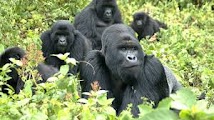As the world is still excited with the
baby born rhino at the Ziwa Rhino Sanctuary, the Rothschild giraffes at Lake
Mburo National Park on other hand have also broken yet another silence with a
newly born Rothschild giraffe making a total of about 17 individuals in this protected area. What
a blessed month for Uganda’s wildlife and conservationists! Just a few days
after when the world celebrated about these eye catching creatures in the wild;
Uganda continues to register tremendous success in its conservation efforts. About 15
Rothschild giraffes were translocated from Murchison Falls National Park in
June 2015 to Lake Mburo National Park in order to diversify the park’s attractions
and also boost the tourism sector in this area. They included 8 females. Murchison
Falls National Park is Uganda’s most extensive savanna grassland protected area
and it boasts of its over 1250 giraffes representing about 75% of all the endangered
Rothschild giraffes that thrive in the world today.
 |
| BABY GIRAFFE |
For that long since they were transferred, it left some people to think that they were brought to help consume the abundant pasture at this park till
recently when these majestic creatures broke the silence and registered their
first baby. As if that wasn’t enough, they have also recorded yet another
remarkable birth and it is exciting news for enthusiastic conservationists.
Giraffes are the tallest mammal species on earth and their height ranges from
4-5 meters and the tallest stretches for about 5.9 meters. Their necks consist
of 7 vertebrae just like humans and most other mammal species. Females give
birth while standing and they have a gestation period of 457 days approximately
one year and three months.
In conclusion, there is still need for
all stakeholders to ensure that giraffes and other wildlife are all well
protected. This will help boost the country’s tourism sector. Giraffes can be spotted in Uganda while you are on a game drive in the savanna grassland protected areas. And besides Lake Mburo National Park, these incredible creatures can also be sighted in Murchison Falls National Park and Kidepo Valley National Park.

